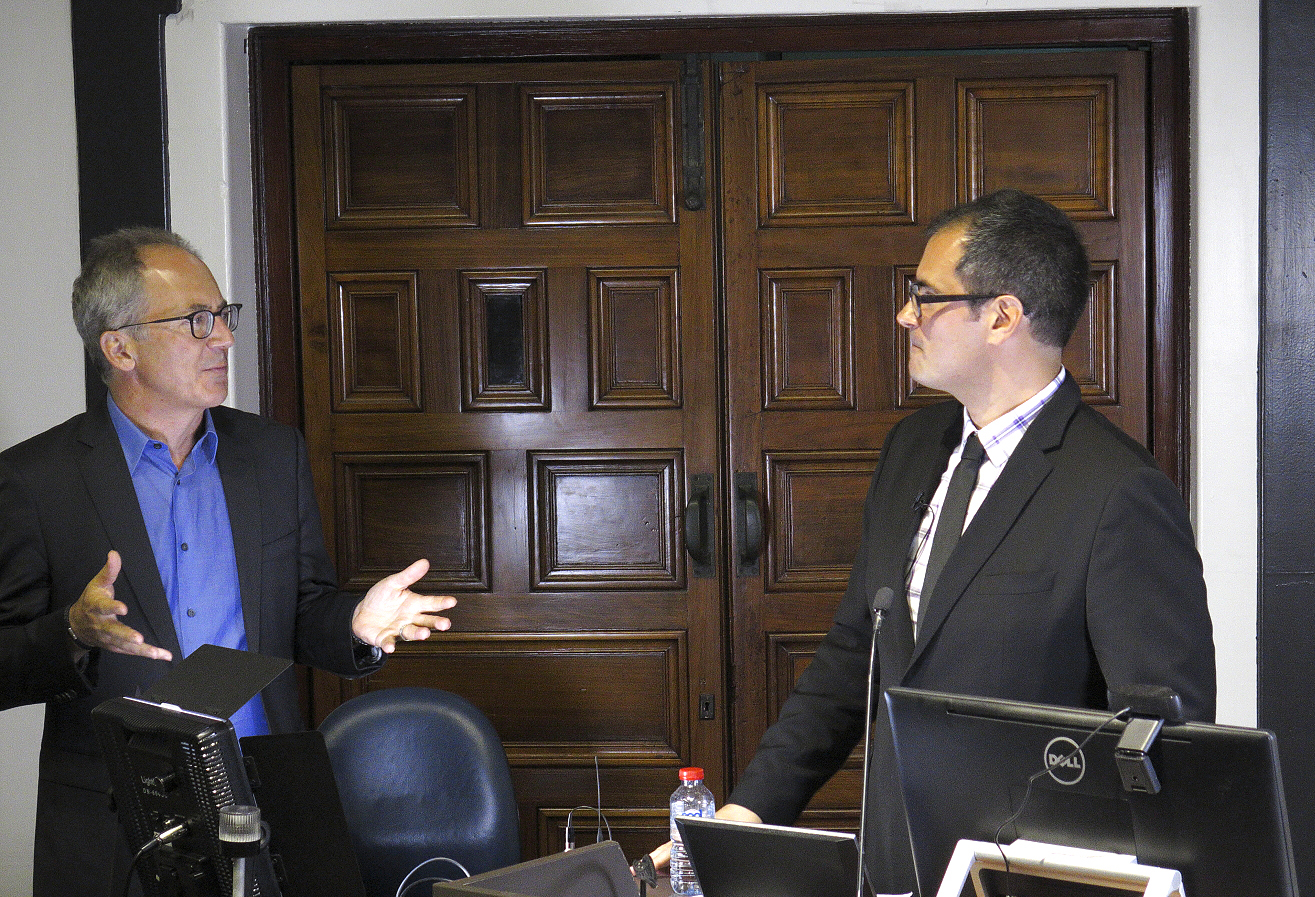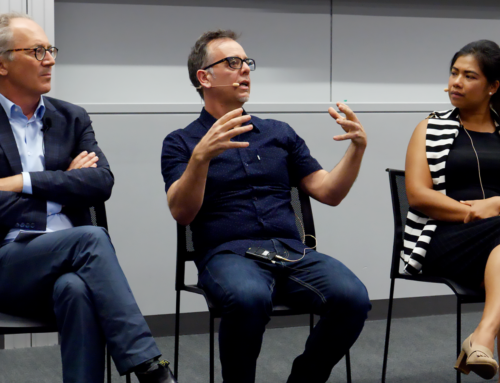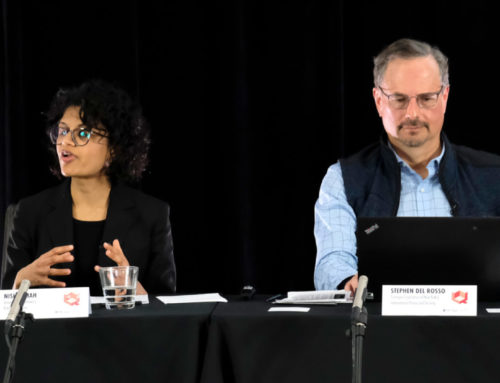While progress towards a meaningful quantum computer has yet to cascade into Moore’s law territory, this year’s Q Symposium—the third such event hosted by the University of Sydney’s Centre for International Security Studies and generously supported by the Carnegie Corporation of New York—gave the impression that significant steps have been taken over the past two years.
By necessity, much of the writing and research of Q1 tended to treat the imminence of quantum technology speculatively. Post-Snowden secrecy combined with the oft-grandiose claims of its potential power made by those in its pursuit led many —myself included—to feel that quantum computing could be a paradigm shift for security on par with nuclear weapons. While this may ultimately prove the case, this year’s conference seemed very consciously engaged with the current reality of quantum technologies and theories, grounding its proceedings in a tone more grounded in the current quantum state of affairs.
This move could not come at a better time. With Project Q and similar efforts (i.e. Alexander Wendt’s publication of Quantum Mind and Social Science) beginning to present the ideas of a quantum social science to the broader community of security scholarship at ISA, the research and thinking around Q must strive to demonstrate the rigor and conceptual clarity necessary to allay competing criticisms of science envy and charlatanism.
Project Q’s transition from thought experiment to something more tangible started the moment this year’s attendees assembled for a tour of the University of Sydney’s sparklingly new Nanoscience Hub on the conference’s first afternoon. Where David Reilly’s Q1 presentation two years prior spoke in only the broadest terms about the potentials of his research, we now found ourselves in a multimillion dollar manifestation of its actuality. Attendees got an idea of the kind of environments and materials necessary for contemporary quantum research on a tour of the Hub’s two main experimental components, Reilly’s Quantum Nanomachines lab and Michael Biercuk’s Quantum Controls lab, given by Biercuk himself and co-investigator Stephen Bartlett.
While Reilly’s nanoscience lab works to create quantum systems by manipulating electrons in solid materials in super-cooled vacuums, Biercuk looks to harness what’s called “quantum simulation”: an idea attributed to Richard Feynman, who once remarked, “Nature isn’t classical, dammit, and if you want to make a simulation of nature, you’d better make it quantum mechanical, and by golly it’s a wonderful problem, because it doesn’t look so easy.”
A tour of Biercuk’s lab showed just how difficult it could look. Contemporary quantum simulation essentially looks to trap individual electrons in an electromagnetic trap known as a Penning trap, where they can be manipulated with lasers. A Penning trap sat on one of the lab’s air-cushioned dampening tables, its slits and windows allowing the passage of only wavelengths necessary for manipulating the atoms of the test element. By manipulating the test element with its corresponding spectra of light, researchers hope to create pancake-shaped crystals of up to a thousand ions which can then be used for quantum simulations in which large, complex systems are represented by simulated models at the quantum scale. (For more in-depth explanation, see this article—Biercuk is a co-author)

Biercuk explains how a Penning trap works in the Quantum Controls Lab. Photo: Gilbert Bel-Bachir.
Biercuk explained that if one could manipulate just three hundred atoms into an entangled system, writing out the state of the system (a Hilbert space equal to 2300) would require all of the matter in the galaxy. Conventional computers—limited as they are by their binary processing capabilities—are vastly inadequate for modeling complexity on this scale. But a quantum simulator, by harnessing the quantum effects of superposition and entanglement, can handle these exponentials much more effectively to simulate highly complex physical phenomena.
But worrying about such physical constraints on experimental data would be putting the cart in front of the horse. Manipulating individual atoms into such a system is a serious feat of physics and engineering that requires a remarkably controlled environment. Biercuk glowed as he gestured at ingenuous features of his lab’s design, which allowed for temperature to be controlled within 0.025°C and for electromagnetic perturbations to be detected and counteracted with compensatory current.
But despite all the astonishing technical achievements, the facility’s single most remarkable feature was the fact that we were in it at all. To this relative outsider, it seemed to represent recent and significant changes to the sociology of quantum research. Coming as it did in the aftermath of the Snowden leaks (one of which disclosed funding for NSA research into quantum computing) Q1 seemed to fit squarely into a security discourse. We were taken with potential with potential applications like quantum gravimetric submarine detection and cryptography; stuck on the secretive, if not sinister, intentions of those backing much of the research; and implicitly identifying quantum research as a new and crucial arms race. And just two years later we were walking through one of the most advanced quantum laboratories in the world, finding it scarcely more secretive or secure than your average campus physics department and its caretakers concerned more with deterring skateboarders and impromptu soccer games on the laboratory’s green roof than any sort of subterfuge.

Michael Biercuk explains the purpose of the Research and Prototype Foundry Lab. Photo: Gilbert Bel-Bachir.
The glassy, open laboratory facility seemed a world away from the ominous promise of “infinity machines” and the vague menace of the NSA’s “Penetrating Hard Targets” cryptography program, whose airing in 2013 lent Q1 an air of skulking in the shadows despite the lush surroundings and Sydneyside sun. While the intelligence and defense communities surely remain involved in the pursuit of effective quantum technologies—IARPA’s public research listings shows four active quantum computing projects; DARPA’s has seven projects with a ‘quantum’ tag; and both are supporting research at the Nanohub—Biercuk and Bartlett seemed to focus more on the wide-range of potential applications with little to no mention of security applications.
Q1 had made a compelling case that security studies had an ethical and practical imperative to understand the implications of new security technologies and the potential of quantum-informed epistemologies for the discipline. Q2 explored the entanglements of big science and big war as integral to the quantum moment, tracing the connections of culture, aesthetics, technology, and politics that helped the quantum turn to come when it did. Having attended all three Q Symposia thus far, I was left to wonder: just what exactly a Q Symposium would look like sans a securitized quantum?
Luckily, fellow repeat attendee Jairus Grove had been tapped to deliver the Symposium’s opening Q-note lecture. After making quite an impression as a last minute fill-in for William Connolly at Q1, Jairus has since joined Project Q as a co-investigator and co-editor of a forthcoming volume. As both a presenter and discussant at the prior Symposia, Grove was uniquely positioned to deliver a lecture that could serve as both a presentation of original research and as a more general state of the Q-nion.
After delivering glowing thanks to James Der Derian, CISS, the University of Sydney, and the Carnegie Corporation for their support, Jairus began by announcing his ambitious hopes for the next forty minutes. He would introduce newcomers and update returnees to Project Q’s work, enunciate what specifically social scientists should look to draw from quantum physics, deepen his claim that the “crisis” of quantum physics was not limited to physics but also happening alongside similar crises in philosophy and social theory, respond to the “science envy” critique, and provide a stronger conceptual foundation for the research of Project Q.

Jairus Grove. Photo: Gilbert Bel-Bachir.
Undaunted by the task before him, he began with his summary of the work thus far. Whether one is enamored with the potential of quantum epistemologically or a post-positivist skeptic wary of the latest fad in science envy, most in attendance can agree that much of the social sciences—particularly those still wedded to behaviorism and positivism—are indebted to a worldview that is out of touch with the actual mechanics of the reality they seek to describe. Grove was careful to point out that these shortcomings, however, are not a reason to jump on the quantum bandwagon. Such a move would amount to trading in one form of uncritical scientism for another. Quantum physics, Grove observed, is not an end of philosophy—the social sciences suffer from first-order metaphysical problems and better knowledge of the empirical world does not make these problems go away.
Quantum Social Theory
Yet rather than rejecting empiricism, the quantum provocation should prompt researchers to embrace weirdness and develop new paradigms for unprecedented findings and ideas. It is Grove’s contention that for many philosophers, artists, and social theorists in the early 20th century, the revelations of quantum theory had done just that. Many leading quantum physicists shared their campuses, clubs, and societies with philosophers and social scientists, as well as a classical educations full of mathematics and philosophy allowing for some shared understandings of one another’s work.
The relativistic and quantum problematizing of discreteness, scale, the nature of space and time, and causality demanded physicists think like philosophers and philosophers think like physicists.
“Why then should it not be the right thing for the physicist to let the philosopher do the philosophizing?” a questioning Einstein opens in Physics and Reality. “Such might indeed be the right thing at a time when the physicist believes he has at his disposal a rigid system of fundamental concepts and fundamental laws so well established that waves of doubt can not reach them; but it can not be right at a time when the very foundations of physics itself have become problematic as they are now.”
Alongside the physicists, thinkers like Alfred North Whitehead “awoke from [a] rationalist slumber” (his words), coming instead to consider a world in which there exists no discreteness between objects and relations—a world that “thus appears as a complicated tissue of events, in which connections of different kinds alternate or overlap or combine and thereby determine the texture of the whole” (Werner Heisenberg’s words). Social theorists and physicists were in dialogue, Grove asserted, “stuck with a lot of the same hard problems, just with different modes of inquiry.”
In Grove’s eyes, Whitehead was amongst the first of what Grove called “quantum social theorists”—a group of thinkers who felt the social world similarly defied mechanistic explanation. But while quantum discoveries may have helped inspire these thinkers’ epistemic and metaphysical inquiries, Grove was careful to point out that their significant contributions are not reducible to physics. While concepts like affect have similar problems with spatio-temporality as early quantum revelations, it can be solved by neither physics nor contemporary constructivist social theorizing, often all too happy to treat it simply as ideational.
“Quantum physics,” Grove announced, “is not the end of philosophy. The social sciences continue to suffer from first order metaphysical problems and better knowledge of the empirical world will not make them go away.” As a response to and acknowledgement of some elements of the post-positivist critique of Project Q, Grove warned that the development of quantum technologies or the simple adoption of quantum metaphor or epistemology into the social science does little to address the same persistent first-order issues at the metaphysical, ethical, and moral levels that have dogged positivist social science.
Affect—the quanta of the social world?
All of Grove’s first wave of quantum social theory—Whitehead’s process philosophy, Gabriel Tarde’s sociology of imitation and social entanglement, and Henri Bergson’s affective philosophy—grapples with this irreducible, indiscrete, entangled sociality. IR, Grove went on to claim, has long been concerned with similarly spooky action at a distance. Nuclear weapons are not maintained to be detonated but to be targeted and pointed at things, to trigger the collective capacities of massive groups of people united in a relationship of fear that cannot be treated merely as a mentalist “state of mind”.
“By what means and medium do you transfer fear?” Grove asked. This is affect. Not merely the ideation of constructivism or the rational choice of methodological individualism, affect is in many ways a quanta-like disruption to the social scientific order. With affect having real effects in the present premised on potentialities (or what Deleuze called ‘virtualities’), it has an ontological realness without materiality. Thought about in these terms, IR as a discipline is rife with such concepts. “Credibility, soft power, resonance…” Grove implored the audience, “they’re ways of articulating fields of force, vectors of relations, for which there is no physical characteristic but also for which it would be inappropriate to say that it’s reducible to the interior of the mind.”
It became clear to me that Grove had managed the remarkable feat of synthesizing the entirety of the conference’s panel topics in one presentation. In affect, Grove had found an element of social science in particular need of a Copenhagen-esque complementarity to resolve the conflict between mentalism and materiality; no less relevant metaphysically now than it had been when Spinoza first penned his Ethics despite centuries of subsequent social theory. The rest of Grove’s talk made a convincing case that this is the ideal moment for social theorists to, in his words, “develop a form of thinking that is not spatio-temporal, but is real.”
Briefly sketching affect, Grove made clear that affect is not emotion but rather ontologically prior, the cause of an emotion. It is a semi-autonomous, “intensive” force (in the sense of Bergson) that has magnitude but cannot be measured. By semi-autonomous, Grove explained that affect has to have an ontological existence irreducible to any of the states of mind that experience it but neither is it fully autonomous or physical. Grappling with affect means asking how we make relationality real rather than a metaphor. Here, Grove makes a crucial departure from the tack taken recently by Alex Wendt to subjugating social phenomena to physics at the expense of materiality. Grove suggests the opposite: everything can be material, but that doesn’t mean that everything is physical.
Affect is non-local. Where Weber struggled to locate charismatic authority in the leader or the constituency, all but abandoning the concept entirely for politics, Grove points to the ties between leader and followers as a truly non-local phenomena that cannot be reduced to either: a relation without location. Affect can be real even if its relationship to physical events is vicarious or specious, and worse it is promiscuous and adhesive to people and things and does not dissipate under the treatment of reason.
Taken together, Grove explained some profound corollaries that deserve to quoted at length.
“Affects such as fear can become events or real virtualities that are only virtually actual. They don’t have substance, but they have effects and they do so by causally tunneling from the future or past. They question the efficacy of past and future as categories. Something that could have taken place can actually have an effect (thinking here of the impact on Holocaust denial on European nationalism), something that might happen can actually have an effect (thinking of the announcement of an ISIS attack within the next year), and those effects are not probabilistic. The affects of those effects are not dependent upon the statistical probability of whether or not either statement is true. And that’s a problem. That’s a problem politically, that’s a problem ethically. Truth is not a regulative ideal for the magnitude and power of affect, which should also tell us something about what ideology critique and the showing of facts can do to politics.”
Grove went on to present a convincing case for a better-theorized affect being a crucial analytical component of understanding contemporary terrorism. Consider ISIS’s decision to publicize that the bomb that brought down a Russian airliner over the Sinai Peninsula last October was concealed in a can of pineapple soda. The move has little tactical purpose—in fact, telling your tradecraft to the world likely does more harm than good to future operations. But understanding ISIS means understanding that they are much more capable regarding affective strategies and techniques than they are on actual battlefield prowess. With propaganda production values rivaling Michael Bay, ISIS’s mastery of the visual medium has amplified their impacts far beyond their physical impacts and capabilities.

The photograph tweeted by an ISIS-affiliated Twitter account, purportedly showing the bomb used to bring down Metrojet Flight 9268 over the Sinai Peninsula on Oct. 31, 2015.
The world in ISIS’s image is one of constant insecurity, where a soda doubles as a bomb, a rock concert as a mass casualty event, and religious practice a sinister threat. Through these affective techniques, ISIS is “terror-forming”—Grove’s term for constructing a world of constant metaphysical unease in which an “affective charging of items, clothing, forms of life, habits which ought not be seen as terrorist, become terrorist imagery.” And while plenty of people—even affect theorists—appeal in vain to rationality to counter its effects (i.e. “you have more likelihood of being hit by lightning than to be killed in a terror attack”), Grove points out that data does not cross the affect threshold in a meaningful way. What does cross the affect threshold is ISIS’s synesthetic images of the body (particularly public executions), which provoke a haptic response, as in the particular way that a beheading video has a unique affinity for grabbing its viewer by the throat, so to speak, through its mixture of sounds and the particularly proprioceptive nature of the throat as the site of the cut.
Collectively held by the throat by both terror-formed objects and the images of terror (both aided by the Western media’s own utilization of affective techniques), the adhesiveness of affect comes to stick to both events and non-events alike. Despite any operational connections to ISIS, the San Bernadino shootings of December 2015 became in effect an ISIS attack as a result affect, ISIS already having attacked the United States affectively plenty over the past two years. The next day, Donald Trump announced that he would seek to block Muslim immigration to the United States and was rewarded with a significant boost in his polling that has since carried him to the Republican party nomination.
Grove closed by bringing quantum back in, and to take his turn at playing skeptic. Contra Heidegger’s sense that “only a god can save us,” Grove critiqued the notion that effective quantum computing seeks to replace the deus with the machina outright. Quantum computers, algorithms, and machine intelligence can’t restore security as it cannot mitigate or respond to our affective mood of pervasive insecurity.
Going back to Spinoza’s Ethics, most of those writing about affect have argued that affect can only be mitigated, shifted, or replaced by other affect. For Heidegger, mood could only be dispelled by mood. For William James, the affective effects of war were so strong that humanity must find its “moral equivalent”—a collective endeavor capable of cultivating similar affects to more constructive ends. Will quantum technology calculate affect? It seems unlikely.
The talk made a convincing case not for a transposition of quantum metaphor, but rather one of methodology. This is not methodology as it is traditionally conceived of in the social sciences, but rather to return, like quantum theorists did, to a method of intuition, imagination, and interpretation when the gears and sprockets of the Newtonian clock got gummed up by the experimental yields of an obstinately irreducible universe.
Affect has a kind of complementarity, captured completely neither by causal nor constitutive logics. It can produce observable effects throughout a social system, while operating on the level of the atomistic. It manifests spooky action at a distance, while defying the mechanistic rationality and mind-body dualisms of traditional social science.
Even the above paragraph smacks of my own attempts to fit affect into the language of quantum mechanics—which are themselves terms of description that cannot quite encapsulate the mathematical essence of quantum phenomena. As social scientists, we are largely denied the elegant and universal language of mathematics, despite our best efforts at quantification. But what we do have is this moment, this crisis—when the empirical reality of our messy social universe confounds our rationalized senses of what is political, what is economic, and what is secure—and with it, provides us with a chance to make the most of a “quantum” moment of our own.







Leave a Reply